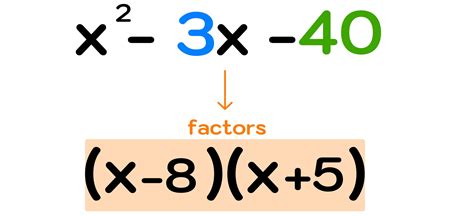Factoring polynomials is a crucial skill in algebra, enabling us to solve equations, simplify expressions, and model real-world problems. A polynomial is an expression consisting of variables and coefficients combined using only addition, subtraction, and multiplication. Factoring involves expressing a polynomial as a product of simpler polynomials, known as factors. In this article, we will explore five effective methods for factoring polynomials.
Method 1: Factoring Out the Greatest Common Factor (GCF)

The first method is to factor out the greatest common factor (GCF) from the terms of the polynomial. This involves identifying the largest factor that divides all terms evenly. By factoring out the GCF, we can simplify the polynomial and make it easier to work with.
For example, consider the polynomial 6x^2 + 12x. The GCF of the terms is 6x. We can factor out the GCF by dividing each term by 6x:
6x^2 + 12x = 6x(x + 2)
Steps to Factor Out the GCF:
- Identify the terms of the polynomial.
- Find the greatest common factor (GCF) of the terms.
- Divide each term by the GCF.
- Write the factored form of the polynomial.
Method 2: Factoring by Grouping

Factoring by grouping is a technique used to factor polynomials with four or more terms. This method involves grouping the terms into pairs and factoring out common factors from each pair.
For example, consider the polynomial x^3 + 2x^2 + 3x + 6. We can group the terms into pairs:
x^3 + 2x^2 + 3x + 6 = (x^3 + 2x^2) + (3x + 6)
Next, we can factor out common factors from each pair:
x^3 + 2x^2 = x^2(x + 2) 3x + 6 = 3(x + 2)
Finally, we can factor out the common binomial factor (x + 2):
x^2(x + 2) + 3(x + 2) = (x^2 + 3)(x + 2)
Steps to Factor by Grouping:
- Group the terms of the polynomial into pairs.
- Factor out common factors from each pair.
- Factor out the common binomial factor.
Method 3: Factoring Quadratic Expressions

Factoring quadratic expressions involves expressing a quadratic polynomial in the form ax^2 + bx + c as a product of two binomial factors. This method requires finding two numbers whose product is ac and whose sum is b.
For example, consider the quadratic expression x^2 + 5x + 6. We can find two numbers whose product is 6 and whose sum is 5:
x^2 + 5x + 6 = (x + 2)(x + 3)
Steps to Factor Quadratic Expressions:
- Write the quadratic expression in the form ax^2 + bx + c.
- Find two numbers whose product is ac and whose sum is b.
- Write the factored form of the quadratic expression.
Method 4: Factoring Using the Difference of Squares

The difference of squares formula is a^2 - b^2 = (a + b)(a - b). This formula can be used to factor expressions of the form a^2 - b^2.
For example, consider the expression x^2 - 9. We can apply the difference of squares formula:
x^2 - 9 = (x + 3)(x - 3)
Steps to Factor Using the Difference of Squares:
- Identify the expression as a difference of squares.
- Apply the difference of squares formula.
- Write the factored form of the expression.
Method 5: Factoring Using the Sum and Difference of Cubes

The sum and difference of cubes formulas are:
a^3 + b^3 = (a + b)(a^2 - ab + b^2) a^3 - b^3 = (a - b)(a^2 + ab + b^2)
These formulas can be used to factor expressions of the form a^3 + b^3 or a^3 - b^3.
For example, consider the expression x^3 + 8. We can apply the sum of cubes formula:
x^3 + 8 = (x + 2)(x^2 - 2x + 4)
Steps to Factor Using the Sum and Difference of Cubes:
- Identify the expression as a sum or difference of cubes.
- Apply the sum or difference of cubes formula.
- Write the factored form of the expression.
In conclusion, factoring polynomials is a crucial skill in algebra that requires practice and patience. By mastering the five methods outlined in this article, you will be able to factor a wide range of polynomials and solve equations with ease. Remember to always check your work by multiplying the factors to ensure that the result is the original polynomial.
We hope this article has helped you understand the different methods of factoring polynomials. Share your thoughts and comments below, and don't hesitate to ask if you have any questions or need further clarification.
What is the purpose of factoring polynomials?
+Factoring polynomials is used to solve equations, simplify expressions, and model real-world problems. By expressing a polynomial as a product of simpler polynomials, we can gain insight into the underlying structure of the polynomial and make it easier to work with.
What are the different methods of factoring polynomials?
+The five methods of factoring polynomials are: factoring out the greatest common factor (GCF), factoring by grouping, factoring quadratic expressions, factoring using the difference of squares, and factoring using the sum and difference of cubes.
How do I choose the correct method for factoring a polynomial?
+To choose the correct method, analyze the polynomial and identify its characteristics. For example, if the polynomial has a GCF, factor out the GCF. If the polynomial is a quadratic expression, try factoring it using the quadratic formula. If the polynomial is a difference of squares or a sum/difference of cubes, use the corresponding formula.
